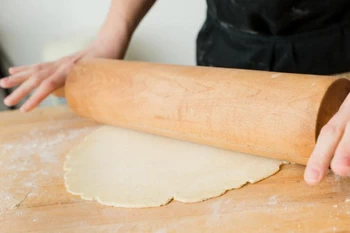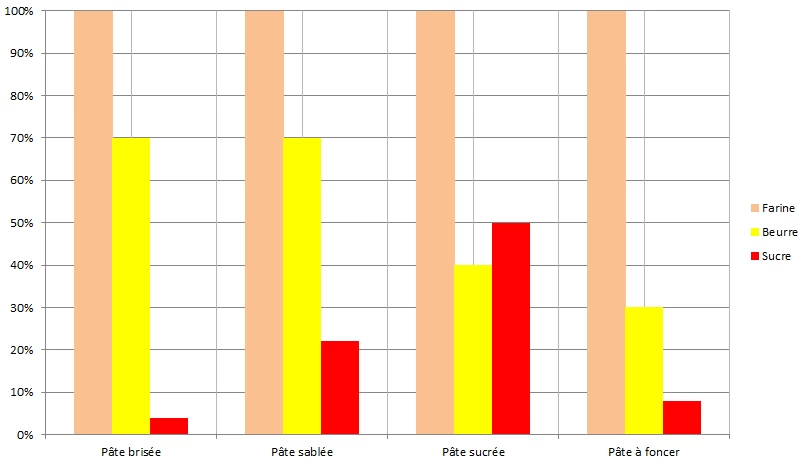This site uses only a few technical cookies necessary for its operation. By continuing to browse, you accept their use.
To find out more...
To find out more...
Pastry doughs

To make a classic tart, you'll need a pastry of course, and if you don't use puff pastry (normally reserved for "fine", in french, tarts), you'll have a choice of shortcrust, shortbread, sweetcrust or "à foncer".
Let's take a look at the differences between these four.
Let's take a look at the differences between these four.
8,799 4.4/5 (8 reviews)
Keywords for this post:PastryDoughShortbreadSweetShortcrustButterSugarFlourProportionsPercentageLast modified on: August 16th 2024
Pastry doughs
First of all, what they have in common: All four are basic French pastry doughs, known as "sèches" (dry). They are made to fill molds, mainly for tarts or tartlets, and are very similar in appearance.
The minimum ingredients, common to all, are :
Here's a table showing the values and percentages of each, for a recipe using 500g of flour:
And the same values in graph form:
Of course, all this is related to the recipes I use, and which are on this same site, but there are practically as many as there are pastry chefs (pro or amateur), which obviously makes the proportions vary, and even sometimes the ingredients: some will tell you that there's no egg, but water or milk, in shortcrust pastry for example.
But here are a few general remarks:
The minimum ingredients, common to all, are :
- Flour
- Butter
- Sugar
- Salt (a little)
Here's a table showing the values and percentages of each, for a recipe using 500g of flour:
| Shortcrust pastry (pâte brisée) | Shortbread pastry (pâte sablée) | Sweet pastry (pâte sucrée) | Pâte "A foncer" | |
|---|---|---|---|---|
| Flour | 500 gr | 500 g | 500 g | 500 g |
| Butter | 350 gr (70%) | 350 gr (70%) | 200 gr (40%) | 150 gr (30%) |
| Sugar | 20 gr (4%) | 110 gr (22%) | 250 gr (50%) | 40 gr (8%) |
And the same values in graph form:

Of course, all this is related to the recipes I use, and which are on this same site, but there are practically as many as there are pastry chefs (pro or amateur), which obviously makes the proportions vary, and even sometimes the ingredients: some will tell you that there's no egg, but water or milk, in shortcrust pastry for example.
But here are a few general remarks:
- As you'll have noticed, sweet pastry lives up to its name: it's very sweet.
- There's a little sugar in pâte brisée, even though it's used in many savoury tarts, and this is important for coloring during baking (see this post on the subject).
- Shortcrust pastry is very well accompanied by the same weight of almond powder as its weight of sugar, which makes it tastier and crunchier - it's even almost indispensable, in my humble opinion.
- It might be tempting to replace butter with vegetable fat in these recipes, but that's not a very good idea, as the taste will be much worse.
- To simplify things a little, we could say that shortcrust and "à foncer" dough are interchangeable for a recipe, and that it's the same for shortcrust and sweet pastry.
- What they all have in common: They like the cold (which is your friend) and don't like to be kneaded or worked, otherwise they become elastic, so you need to mix their ingredients as quickly as possible.
- What they all have in common: Ideally, they should be made the day before and left overnight in the fridge before use, and they freeze well raw, in the form of a large cake, not a ball.
Lasts posts
Butter vs. grease
We often read in a recipe where a pastry is put into a mould that, just before pouring, the mould should be buttered or greased. But what's the difference between these 2 terms?December 1st 20251,5655
Getting out of the fridge early
Very often when you're cooking, you need to take food or preparations out of the fridge, to use them in the recipe in progress. There's nothing tricky about this: you just take them out of the fridge and use them, usually immediately, in the recipe. But is this really a good method?November 24th 20251,2995
Who's making the croissants?
When you look at a bakery from the outside, you naturally think that in the bakery, the bakers make the bread, and in the laboratory, the pastry chefs make the cakes. It's very often like that, with each of these professions having quite different ways of working, but sometimes there's also one...November 23th 20251,195
Oven height
When we put a dish or cake in the oven, we naturally tend to put it on the middle shelf, and that's what we usually do. But in some cases, this position and height can be a little tricky, so let's find out why.October 8th 20253,4235
The importance of sieving
In recipes that use a fine powder (flour, powdered sugar, etc.), you'll often see the advice to sift before using it. To sift is to pass the powder in question through a sieve (a very fine strainer) before incorporating it into your recipe. It's often advice, but is it really useful?September 3rd 20258,0043
Other pages you may also like
How to avoid lumps
You've probably come across this unpleasant phenomenon where, when you try to incorporate an ingredient (usually a solid or powder) into a preparation (usually a liquid), the mixture doesn't mix properly and you end up with little "balls" or little lumps of the solid part that refuse to mix with the...October 9th 202023 K4.8
Tranché, dissociated, failed, in short... missed!
When preparing a sauce or a cream, there's always a (small) risk that the creamy preparation you're working on will suddenly separate into two parts of different textures: a liquid part, for example, and a more or less solid part, or even become lumpy. It's terribly frustrating, but we'll see...June 19th 202313 K5
Coarsely chopped herbs
Although we are in the middle of winter as I write these lines, you should not hesitate to make salads at this time, it is actually quite simple, rather fast, and so pleasant. A while ago, I already told you that a salad is a salad, but a salad with herbs is immediately something much better:...January 9th 202115 K4.9
Baking cakes
Where we see that to put a cake in the oven, once the dough is finished and in its mould, there is no hurry and that the cold is your friend.June 28th 201945 K4.1
The color of the bread crumb
When you go to buy bread, at your baker's, at the time of the choice, if you hesitate of course, you will undoubtedly be very sensitive to the color of the crust, and you will be right. The color of the crust, from golden, to sometimes very dark, deep brown almost black, depending on the maturity...April 30th 202221 K4.6
Post a comment or question
Follow this page
If you are interested in this page, you can "follow" it, by entering your email address here. You will then receive a notification immediately each time the page is modified or a new comment is added. Please note that you will need to confirm this following.
Note: We'll never share your e-mail address with anyone else.
Alternatively: you can subscribe to the mailing list of cooling-ez.com , you will receive a e-mail for each new recipe published on the site.









